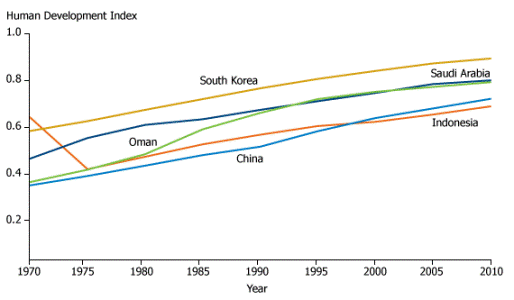
Human Development Report Includes New Measures of Global Inequality, Gender Equity, and Poverty
(December 2010) Ask experts how poverty is measured, and you will get a variety of responses. Some define poverty strictly by income, some by how much of one’s basic needs such as food or housing are met; others interpret poverty as a condition reflecting a lack of choice and rights in determining one’s path in life. This mix of outlooks and definitions makes it difficult to gauge the extent and nature of global poverty and success in addressing it. In addition, scarcity of reliable country-level data in many developing countries has consistently been an obstacle in accurately measuring the scope and nature of poverty.
The United Nations Development Programme’s (UNDP) annual Human Development Report (HDR) and its Human Development Index (HDI) provide an important yardstick in measuring global poverty by looking at poverty beyond just income. The HDI examines three dimensions with corresponding indicators—health, education, and living standards—and gives each country a score ranging from 0 to 1, with 1 being the highest.
How are the dimensions measured? Health has long been measured by life expectancy at birth. But this year’s HDI measures education and living standards in new ways. Progress in education is now determined by calculating the mean number of years of schooling for adults ages 25 and older along with the expected number of years of schooling for school-age children. Income measurement has shifted this year from per capita gross national product (GDP) in previous years to gross national income (GNI) this year.1
Progress for Most Countries
Countries with the most progress according to the HDI since 1970 include well-known economic success stories such as China, Indonesia, and South Korea (see figure). But others, including Nepal, Oman, Tunisia, Ethiopia, Botswana, Benin, and Burkina Faso, have also made significant gains. At a global level, it is evident from looking at 135 countries that there have been dramatic improvements: Life expectancy rose from 59 to 70 years, school enrollment is up from 55 percent to 70 percent, and per capita income more than doubled to $10,000.
Countries With Most Improvement in Human Development Index, 1970-2010

Source: UNDP, Worldwide Trends in the Human Development Index 1970-2010, accessed at http://hdr.undp.org/en/data/trends/, on Dec. 8, 2010.
But these global figures mask wide variations among countries and ignore income inequality. Differing institutions, policies, and politics at the country level influence the progress made in health, education, and economic growth. And in three cases—the Democratic Republic of Congo, Zambia, and Zimbabwe—the HDI are at lower levels than in 1970.
New Measures More Accurately Convey Breadth and Depth of Global Poverty
New advances in methodology and data quality have led to three new indices to measure inequality, gender equity, and poverty in this year’s report.
- The Inequality-Adjusted Human Development Index takes unequal access to health services and education, and levels of income, into account to create a more accurate picture of HDI; the higher the level of inequality in a country, the larger the difference between the IHDI and the HDI. According to UNDP, “The IHDI is the actual level of human development…while the HDI can be viewed as an index of ‘potential’ human development…that could be achieved if there was no inequality.” On average, there is a 22 percent loss in HDI because of inequality, ranging from a high of 45 percent in Mozambique to 6 percent in the Czech Republic. Countries with lower HDI scores tend to have higher inequality in multiple dimensions.
- The Gender Inequality Index focuses on women’s disadvantages in reproductive health, empowerment, and labor and reflects inequality between men and women. This index varies across countries, with losses in human development due to gender inequality ranging from 17 percent to 85 percent. Denmark, Sweden, and Switzerland are considered the most gender-equal countries, while the Central African Republic, Haiti, and Mozambique are the most unequal.
- The Multidimensional Poverty Index supplements income-based measures of poverty by incorporating other deprivations in health, education, and standards of living. The measure is based on household survey data and each person in a household is classified as either poor or nonpoor depending on how many deprivations his or her household experiences. Multidimensional poverty is defined as having at least 30 percent of the indicators showing acute deprivation in health, education, and standard of living. According to this measure, there are more people living in poverty worldwide than other estimates show. The HDR finds that 1.75 billion people worldwide (one-third of the population of the 104 countries covered by the poverty index) live in multidimensional poverty—more than the 1.44 billion people living on $1.25 a day or less (the common World Bank definition of extreme poverty). The results reflect important variations between income poverty and multidimensional poverty: In some countries such as Ethiopia and Guatemala, the number of people who are multidimensionally poor are higher; whereas in other countries such as China and Tanzania, the rates of income poverty are higher.
Eric Zuehlke is an editor at the Population Reference Bureau.
Reference
- GNI includes remittances and foreign assistance income.
